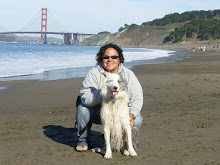Scientists pinpoint origins of little dogs
Big dogs came first; little ones arose 12,000 years ago in Middle East
By Jennifer Viegas Discovery Channel
Small dogs the world over can all trace their ancestry back to the Middle East, where the first diminutive canines emerged more than 12,000 years ago.
A new study, which appears in BMC Biology, focused on a single gene responsible for size in dogs. Researchers found that the version of the gene IGF1 that is a major determinant of small size in dogs probably originated as a result of domestication of the Middle Eastern gray wolf, which also happens to be smaller than many other wolves.
In terms of which came first, big dogs or small dogs, the answer is now the former.
"Archaeological studies suggest that ancient (dog) remains found in Belgium, Germany and Western Russia, which date to 13,000-31,000 years ago, were most similar in body size to the Great Dane, while those from the Middle East dating to about 12,000 years ago were most similar to a small terrier," lead author Melissa Gray told Discovery News.
For the study, Gray, a researcher in the Laboratory of Genetics at the University of Wisconsin, Madison, and her colleagues traced the evolutionary history of the IGF1 gene. To do so, they surveyed a large sample of gray wolf populations, other wild members of the Canidae family, and numerous breeds of dogs.
Gray and her team first confirmed that all domesticated dogs trace their heritage back to gray wolves. She indicated the jury is still out as to when and where the world's first dog — of any size — emerged.
All small dogs, normally weighing 20 pounds or less, share the variant of IGF1 also found in Middle Eastern gray wolves, the scientists discovered. This means the gene must have surfaced early in the history of small dogs, but after dogs in general were first domesticated.
The DNA studies, combined with the archaeological record, then suggest that at least 12,000 years ago, the first domesticated small dogs entered the world, with humans playing a major role in the process.
"(There) could have been a mutation arising early in the history of dogs," said Gray, "which was maintained by breeding and artificial selection by humans, or could have been an adaptive trait that developed during domestication as a means to coexist with humans."
The timing and location provide intriguing clues, as Middle Eastern societies then were moving away from the hunter-gatherer lifestyle and towards agriculture-based communities.
"Small (dog) size could have been more desirable in more densely packed agrarian societies where dogs may have lived partly indoors or in confined outdoor spaces," Gray explained.
"It is unlikely that dogs at that time were used as a source of protection, but more likely that they were used initially for their fur, as a food source, and possibly companionship," she added.
Reduction in body size is a common feature of domestication and has been observed in other animals, such as cattle, pigs and goats.
David Macdonald of the University of Oxford and Carlos Driscoll of the National Institutes of Health point out in a separate paper in the Journal of Biology that most of the Western barnyard animals were domesticated beginning at around the same time 12,000 years ago.
Dogs stood out from the rest, however, because they were "in the role of not just a treasured companion, but a precursor to wealth and inequality" since "dogs are likely to have become status symbols as well as being intrinsically valuable," Macdonald and Driscoll wrote.
© 2010 Discovery Channel
URL: http://www.msnbc.msn.com/id/35564095/ns/technology_and_science-science/
Subscribe to:
Post Comments (Atom)





No comments:
Post a Comment